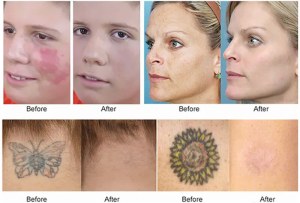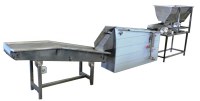Want to get rid of a tattoo you've outgrown? Of all of the methods available to remove or alter a tattoo including lightening creams, excision, surgery, and microdermabrasion, picosecond laser tattoo removal machine is becoming the most popular and effective. Picosecond Pulsed Laser technology has advanced, and tattoos are no longer permanent. It's no longer painful or difficult to remove large and colorful tattoos. The de-inking process has evolved in recent years, from embarrassing and potentially skin-damaging process to a safer, more sophisticated laser technology. Bestview Laser is a China picosecond laser in laser beauty equipment manufacturer.
Q-Switched lasers have traditionally been the gold standard method used for removing tattoos, and still are, but with the advent of picosecond technology, the treatment was made quicker, and in some cases, more efficient and less painful, depending on the tattoo type. Unlike the Q-Switched laser treatments that use intensive laser energy to heat up and break the tattoo ink particles into smaller pieces, picosecond lasers offer patients a much gentler and more effective treatment as picosecond laser tattoo removal doesn't use any heat. It uses photoacoustic effect, ultra-short laser pulses, to shatter the ink particles at very high pressure. The Picosecond laser fires pulses at a trillionth of a second and shatters the ink into tiny dust particles which can be absorbed much more quickly and easily, and eventually get eliminated by the body.
Factors which will influence the effectiveness of picosecond laser tattoo removal:
*Concentration of pigment: If the tattoo pigment density is distributed at the bottom layer of the skin.
*Location: If the tattoo is located at the end of the limbs, where the lymphatic circulation is relatively poor, and the color is also difficult to resolve.
*Age of Tattoo: If the tattoo is more than one year old, then it's easier because the pigment has been partially metabolized by the lymphatic circulation.
*Color: Due to the different chemical composition of the pigment, the reaction to the laser is also different. Generally, black is the easiest color to remove, red and green are not easy, because these two colors are not easy to absorb laser light.
How Long To See Results From Picosecond Laser Treatments (Timeline)
Wondering ‘how long to see results from a picosecond laser?' Typically, visible improvements start to emerge 2-3 weeks post treatment, with ongoing enhancements as your skin naturally heals. Read on as we break down the factors influencing your personal timeline and what to anticipate at each stage of the process.
#Understanding the Timeline of Picosecond Laser Results
The picosecond laser treatment offers a non-surgical approach to addressing various skin conditions and has become increasingly popular for those seeking enhanced skin rejuvenation. Utilising extremely brief bursts of laser energy, the procedure thoroughly revitalises the skin without imparting heat, thereby minimising discomfort. Within just two to three weeks after receiving this gentle yet effective treatment, patients often begin noticing an improved complexion and smoother skin texture—a transformation that continues progressing towards their ultimate goal.
Nevertheless, when it comes to observing tangible results from picosecond laser treatments, patient experiences will differ based on several contributing elements such as age, specific skin condition being treated, individual's natural skin type and tone, along with how pronounced the targeted concern may be.
Thus, prescribed timeframes can vary. Some individuals see changes promptly within a few weeks, while others require additional patience before witnessing improvement. This bespoke process is what makes each person's journey toward betterment uniquely their own through the tailored application of Picoseocnd Laser technology.
#Initial Changes Post-Treatment
Following your Picosecond treatment, it's common to experience certain reactions in the skin, which can include:
*Minor bruising.
*A reddened appearance.
*Swelling at the site of treatment.
*Sensations that may remind you of a sunburn.
These are normal responses due to the enhanced circulation to the area receiving treatment and they typically diminish within a few hours after the procedure. It is important during recovery not to scratch or rub on these areas for proper healing. There could also be a slight darkening or bronzing of your skin appearing between 3 and 10 days post-treatment. This is especially noted with lighter skin tones experiencing mild scarring. These preliminary changes signify that your skin is undergoing its transformation towards a more luminous state.
#Visible Improvements and Skin Healing
Upon beginning your journey with Picosecond laser treatments, the initial fruits of skin revitalisation tend to manifest between 2 and 3 weeks post-treatment. This is when you may notice enhanced brightness and a renewed look that serve as an introduction to Improvements. These enhancements from the laser therapy will continue to emerge slowly as they are intrinsically linked to your body's own regenerative capabilities.
As this regeneration advances, one can expect gradual refinement in both the texture and tone of their skin along with a reduction in issues related to skin pigmentation. Post-laser treatment, it's common for pigmented areas on the skin to appear darker over a span ranging from 1 week up until about 3 weeks. Subsequently, these darkened spots begin lightening—a clear indicator marking progress within the healing timeline following your procedure. Your complexion undergoes an exquisite transformation during which it discloses its newfound glow bit by bit.
#Long-Term Effects on Skin Quality
Laser treatments with a picosecond laser not only yield immediate enhancements, but also promote lasting improvements in skin health. These long-term benefits manifest through improved signs of facial photoaging, including better skin texture and reduced dyspigmentation. The remarkable effect of the fractional picosecond laser is its stimulation of natural skin regeneration and remodelling in the dermis.
The quality of your skin will keep on improving after the treatment, exhibiting diminished pigmentation and fewer wrinkles. Reports suggest that even six months post-treatment, individuals experienced noticeable reductions in pore size following their fractional picosecond laser sessions.
To elevate your results Consider combining picosecond laser procedures with other aesthetic treatments like fillers or botulinum toxin injections. This can enhance overall outcomes and create complementary effects for more comprehensive facial rejuvenation.
#The Speed of Results for Common Skin Concerns
Laser treatments utilising picosecond lasers are adept at tackling various skin concerns, such as reducing pore size, enhancing pigmentation and increasing clarity of the skin. Impressively, these improvements can often be noticed just a week after undergoing treatment. To fully address pigmentation problems, it may require approximately three to four sessions with a picosecond laser. Similarly, treating acne scarring effectively might necessitate about four treatments.
Specifically using the Picosecond laser highlights its swift efficacy by noticeably diminishing pore sizes usually within one or two treatments – a testament to how quickly picosecond laser treatments can improve skin texture. While individual results timelines may differ slightly from person to person based on their unique issues and goals for their skin's appearance. It is clear that each session will contribute progressively towards achieving those desired outcomes in your complexion.
#Addressing Acne Scarring with Picosecond Laser
Utilising picosecond lasers has revolutionised the treatment of mild atrophic acne scars and inflammatory hyperpigmentation. To achieve desirable outcomes, individuals with first-degree acne scarring may undergo 2 to 5 sessions using a picosecond laser. This method is customised according to each patient's unique scar severity and type.
#Fading Hyperpigmentation and Age Spots
Picosecond lasers are highly effective at addressing pigmentation conditions including freckles, sunspots, and melasma. These advanced lasers have been specifically engineered for the elimination of pigment and excel in clearing post-inflammatory hyperpigmentation resulting from acne. They also perform well in treating unspecific pigmentation issues prevalent in darker skin types, along with certain congenital marks.
#Factors Influencing Your Picosecond Laser Results Timeline
Picosecond laser treatments serve as a powerful method for enhancing skin health, although the timeframe to witness results is not fixed. It depends on various elements, including the nature of your skin type, how regularly you undergo treatments and the way you maintain your skin after treatment sessions. The Picosecond laser provides a safe option applicable to all kinds of skins and complexions with its gentle non-abrasive technique that leaves the skin's surface intact.
When undergoing picosecond laser therapy, energy is directed towards pigmentations in a manner that prompts an intense shock wave effect which then catalyses collagen production leading to clearer and more rejuvenated skin. Factors such as one's natural amounts of collagen and elastin along with their inherent rate of cell regeneration (particularly slower cycles often associated with ageing) can significantly impact when improvements become noticeable.
Various specific settings used during treatment influence this timeline.
*Wavelength.
*Pulse duration.
*Area being targeted.
*Energy density.
These are fine-tuned according to an individual's unique complexion needs hence play an essential role in determining when one may see outcomes from picosecond laser interventions.
#The Role of Treatment Frequency
Every individual is distinctive, just like their skin. When it comes to scheduling of picosecond laser treatments, customisation is key and depends on various elements such as the extent of one's skin issues, personal treatment goals, and how well one's collagen production reacts to the therapy. For instance, dealing with moderate concerns like apparent pigmentation or early signs of fine lines may warrant a regimen where sessions are spaced every 3 to 4 weeks apart in order to maintain steady collagen synthesis and secure noticeable progress.
In contrast, more acute skin problems such as heavy pigmentation loads, resistant scarring or pronounced wrinkles might necessitate an intensified frequency of treatments at intervals ranging from 2 to 3 weeks in pursuit of substantial and expedited enhancement. Conversely, those grappling with minor pigment-related conditions or aiming for upkeep following previous interventions could opt for extended gaps between appointments. This often falls between every 4 to 6 weeks interval. Ultimately it's about striking an equilibrium that aligns optimally with both your dermal health requisites and daily life demands.
#Lifestyle and Aftercare
Just as careful cultivation is essential for a plant's growth, diligent post-care is vital to ensure your skin recovers optimally after undergoing picosecond laser treatments. An integral aspect of this care regimen includes shielding the skin from the sun to avoid hyperpigmentation and increased sensitivity following treatment. Thus, it's imperative to apply broad-spectrum sunscreen consistently with an SPF of 30 or higher.
Following picosecond laser treatment, your skin requires a gentle approach. Steer clear of hot water. Instead opt for a mild oil-free cleanser capped off with light moisturization in support of healthy recovery. Steer clear from engaging in other facial treatments such as fillers, botox or chemical peels shortly after having undergone picosecond laser therapy so that you do not interrupt the natural healing process of your dermis.
Bear in mind that achieving revitalised skin is more akin to a marathon than a quick race – patience coupled with meticulous post-laser care constitutes part of this enduring voyage towards rejuvenation.
#Comparing Picosecond Laser to Other Lasers
Picosecond lasers represent a significant advancement in the care of skin, but they are not alone in this arena. Previously, nanosecond duration lasers, like the conventional Q-Switched models, were considered top-notch for addressing pigmented dermal issues such as melasma and wrinkles, besides being pivotal for tattoo removal. How do picosecond lasers compare with these earlier technologies?
Q-Switched lasers have been known to effectively disintegrate larger spots of pigmentation. Nevertheless, employing picosecond lasers subsequently can shatter these pigment fragments even smaller to facilitate more thorough clearance. There could be scenarios where alternative laser options might better serve specific dermatological needs. Ultimately when selecting a laser treatment modality it comes down to pinpointing what exactly is required for each unique skin concern at hand.
#Picosecond Laser's Edge in Efficiency
Picosecond lasers excel in delivering effective and gentle treatment thanks to their non-ablative laser energy. The Picosecond's unique Pressure Wave technology is specifically designed for a smoother and more efficient therapy process. Using ultra-brief pulse durations, devices like the Bestview Laser enhance the overall efficiency of treatments by cutting down on required pulses while also reducing thermal heat accumulation.
#Realistic Expectations: What Can You Anticipate After Your First Picosecond Laser Session?
Do not expect a significant change in your skin immediately following your first Picosecond laser treatment. Your skin may feel sensitive and you might notice minor swelling, but these side effects Diminish within a day or even just a few hours.
The full benefits of the picosecond laser treatments on your skin tend to emerge over several weeks rather than instantaneously. Thus, it's important to remain patient throughout the process. Adhering diligently to the series of treatments recommended by your aesthetic doctor is crucial for achieving optimal results with picosecond laser therapy.
#Journey Through Recovery: From Treatment to Transformation
Your skin transformation journey begins with a primary consultation where you and your aesthetic doctor will establish the treatment plan, define goals, and set expectations. During this initial meeting, an evaluation of your current skin condition and skincare practices will take place to craft a strategic approach for achieving desired results.
Critical to this process are the follow-up appointments that serve as checkpoints along your path. These sessions allow for monitoring of how well the skin is responding to treatments. Adjustments can be made accordingly during these visits. Particularly in the weeks immediately following treatment, it's imperative to observe any alterations in texture or coloration of the skin which signal its healing progress.
Location : HENAN NEW-TECH MARKET.NO 199, YANG JIN ROAD, JINSHUI DISTRICT ZHENGZHOU, CHINA., 450003 Zhengzhou,
Contact : Best Bvlaser, 0086 19503862093











